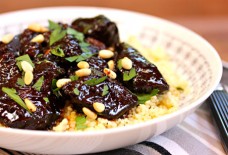A female lens focuses on the Middle East in 'She Who Tells a Story'
By Daniel Solomon / Pittsburgh Post-Gazette
“She Who Tells a Story” has at least one for everyone.
The Carnegie Museum of Art exhibition of 12 women’s photography from the Arab world and Iran engages both uninitiated and expert. For the latter, the show’s broad reach can be frustrating. But at a time when many Americans see the Middle East as a place of violent men and silent women, the exhibition’s curators decided to challenge those assumptions in a way that’s relatable to a general audience. In the process, “She Who Tells a Story” manages to pose some nuanced questions about political conflict and personal identity. It opened in May and closes Sept. 28.
Rania Matar’s photos from Lebanon are a good starting point for the show’s humanist message. Representing different cultural orientations, several women sit in the privacy of their bedrooms. One has modern art on the walls and beauty products on the bureau. Another has a Persian rug on the floor and a hijab (head scarf) on the nightstand. Whatever her position in a country that straddles East and West, each appears to relish the solitude of her space. People in the Middle East have inner lives, too, the exhibit screams. Series from Egypt, Iran and the Gaza Strip continue that theme, which might seem banal but for our own ignorance.
Other photographers go further. In the explanatory note that precedes the exhibition, the curator notes that one of the show’s goals is to push back against Orientalism, a 19th-century trend in Western art and literature that depicted the peoples of the Middle East as exotic and primitive. In one portrait from Morocco’s Lalla Essaydi, a Scheherazade-like seductress stretches out on a bed with a floral print spread, staring at her admirers off-screen. Gold and silver bullet casings make up the piece’s decorative patterns, a commentary on the efforts of European imperialists and Islamic extremists to shape the image — and by extension, limit the agency — of the region’s women.
Among the 12 photographers with work on display, two engage the full range of the viewer’s intellect — Rula Halawani, with her pictures from the West Bank, and Boushra Almutawakel, with her portraits from Yemen.
Shooting during the Second Intifada, Ms. Halawani recorded scenes of Israel’s incursion into the West Bank. Tanks roll down the streets. People huddle in the rubble of their homes. Using black-and-white film, Ms. Halawani opted not to reverse the light and dark values when she developed the images, making them look like negatives. What should be black is white and what should be white is black, a trick that highlights Palestine’s topsy-turvy political situation.
With their smears of light and dark, the images blur the line between dream and reality, speaking to the unreal, nightmarish quality of Israel’s occupation of Palestinian land. That half-centurylong regime has included restrictions on daily life so capricious, and legal procedures so arcane, to suggest comparisons with a Kafka novel. Ms. Halawani distills these feelings in creative shots that encourage further reflection.
Ms. Almutawakel’s photos examine where choice ends and coercion begins. Her nine portraits feature a mother, a daughter and a doll in progressive stages of veiling. As the coverings become darker and more extensive, the expressions of parent and child grow more ominous — that is, until we no longer see their faces. In the last panel, the women’s figures, completely shrouded in black, cannot be discerned from the backdrop.
Meant as a protest against Islamic extremists’ attempt to impose the niqab (face veil), Ms. Almutawakel’s work also indicates that covering does not have to be oppressive. In the first image, mother and daughter beam, the former in a light-colored hijab. In the third panel, parent and child still wear smiles, even as their clothing has turned more conservative. Although it’s clear what’s bad on the margins, it’s hard to decide when piety merges into self-abnegation.
Launched at Boston’s Museum of Fine Arts, “She Who Tells a Story” invites spectators to expand their understanding of the Middle East and the women who define it. While the exhibition is often simplistic, that says more about us than it does about the photos.
“She Who Tells a Story” runs through Sept. 28 at Carnegie Museum of Art, 4400 Forbes Ave., Oakland. Rania Matar will give a free talk about her work at 6 p.m. Sept. 15. Admission: adults, $19.95; seniors, $14.95; children, $11.95. Hours are 10 a.m.-5 p.m. Monday, Tuesday, Wednesday, Friday and Saturday; 10 a.m.-8 p.m. Thursday; and noon-5 p.m. Sunday. Information: www.cmoa.org.
Daniel Solomon is a former intern at the Post-Gazette.
Source: www.post-gazette.com


